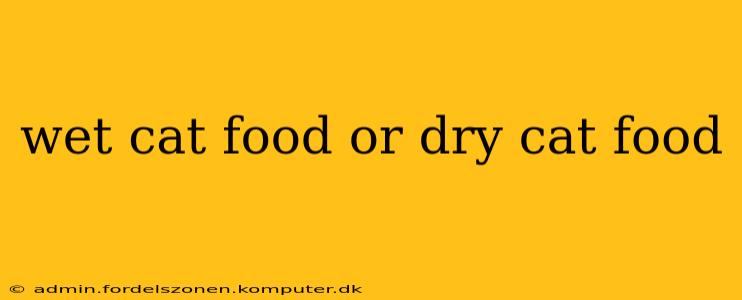Choosing between wet and dry cat food can feel like navigating a maze. Both options offer nutritional value, but understanding their differences is crucial for your cat's health and happiness. This comprehensive guide will delve into the pros and cons of each, helping you make the best decision for your feline friend.
What's the Difference Between Wet and Dry Cat Food?
The primary difference lies in moisture content. Wet cat food, also known as canned cat food, typically contains 70-80% moisture, while dry cat food (kibble) contains only 5-10%. This significant difference impacts various aspects of your cat's health and dietary needs.
Advantages of Wet Cat Food
- Higher Moisture Content: This is a major advantage, especially for cats prone to urinary tract issues. Increased water intake helps dilute urine, reducing the risk of crystals and stones. Many cats simply don't drink enough water, and wet food helps compensate.
- More Palatable: Many cats find wet food more appealing due to its aroma and texture. This is especially true for picky eaters or senior cats with dental issues. The soft texture is easier to chew.
- Higher Protein Content (Often): While not always the case, many wet food formulas boast a higher protein percentage compared to dry kibble. Protein is vital for a cat's muscle mass, coat health, and overall well-being.
Disadvantages of Wet Cat Food
- Higher Cost: Wet food is generally more expensive than dry food per calorie.
- Shorter Shelf Life: Once opened, wet food needs to be refrigerated and used within a few days to prevent spoilage.
- Messy: Feeding wet food can be messier than dry food, requiring more frequent cleaning of food bowls.
Advantages of Dry Cat Food
- Cost-Effective: Dry cat food is typically more affordable than wet food.
- Longer Shelf Life: Dry food has a much longer shelf life, both unopened and once opened (provided it's stored correctly).
- Convenient: It's easy to store and doesn't require refrigeration.
- Dental Health: The chewing action of dry kibble can help clean your cat's teeth, reducing plaque buildup.
Disadvantages of Dry Cat Food
- Lower Moisture Content: The low moisture content can contribute to dehydration, increasing the risk of urinary tract problems.
- Less Palatable (for some cats): Some cats find dry food less appealing than the richer aromas and textures of wet food.
- Lower Protein Content (Sometimes): While not always the case, some dry food formulas may contain a lower protein percentage compared to some wet food options. Always check the ingredient list and guaranteed analysis.
What Type of Food is Best for Kittens?
Kittens have different nutritional needs than adult cats. They require food with higher calorie density to support their rapid growth. While both wet and dry foods are available for kittens, many vets recommend a combination to ensure adequate hydration and caloric intake. Always follow the feeding guidelines on the packaging, and consult your veterinarian for specific recommendations for your kitten.
Can I Mix Wet and Dry Cat Food?
Absolutely! Many cat owners successfully combine wet and dry food to reap the benefits of both. This approach can be particularly helpful for picky eaters or cats with specific dietary needs. You can mix them in the same bowl or offer them separately throughout the day.
How Much Should I Feed My Cat?
The amount of food you should feed your cat depends on several factors, including breed, age, activity level, and overall health. Always follow the feeding guidelines on the food packaging and adjust as needed based on your cat's weight and body condition. Consult your veterinarian for personalized feeding recommendations.
Which is Better for Senior Cats?
Senior cats often have reduced appetites and may require food that’s easier to digest. Wet food's higher moisture content and softer texture can be beneficial for senior cats with dental issues. However, some senior cats also benefit from the dental benefits of dry kibble. A balanced approach, considering your cat's specific needs, is often best.
Conclusion: The Best Choice is Individual
Ultimately, the best type of food for your cat depends on their individual needs, preferences, and any health concerns. Consider factors like age, activity level, and any existing medical conditions. Consult with your veterinarian to determine the most appropriate food choice for your feline companion. They can provide personalized advice based on your cat's unique situation and help you navigate the world of wet and dry cat food.
